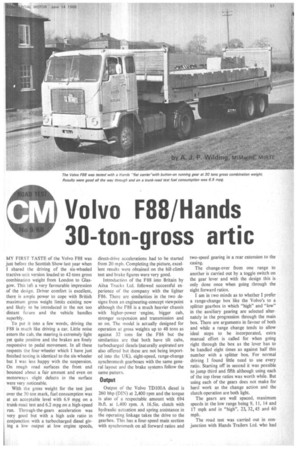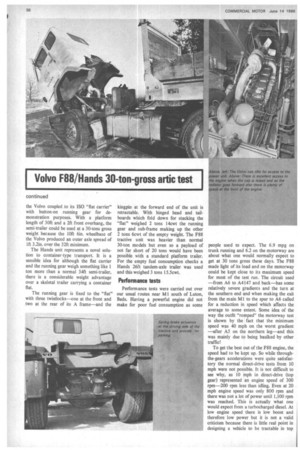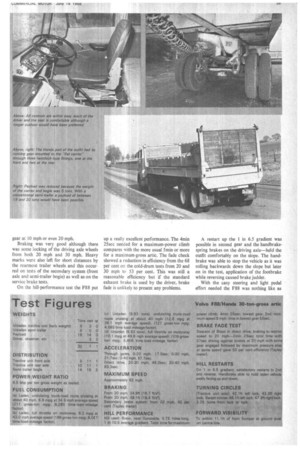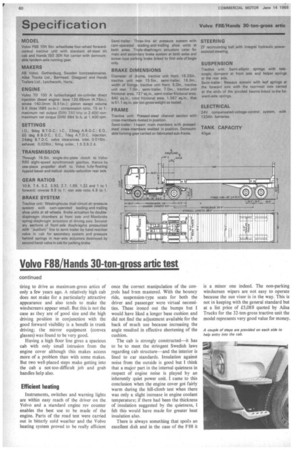Volvo F88/Hands 30-ton-gross artic
Page 59

Page 60

Page 61

Page 62

If you've noticed an error in this article please click here to report it so we can fix it.
MY FIRST TASTE of the Volvo F88 was just before the Scottish Show last year when I shared the driving of the six-wheeled tractive-unit version loaded to 42-tons gross combination weight from London to Glasgow. This left a very favourable impression of the design. Driver comfort is excellent, there is ample power to cope with British maximum gross weight limits existing now and likely to he introduced in the not too distant future and the vehicle handles superbly.
To put it into a few words, driving the F88 is much like driving a car. Little noise enters the cab, the steering is extremely light yet quite positive and the brakes are finely responsive to pedal movement. In all these respects the four-wheeler which I have just finished testing is identical to the six-wheeler but I was less happy with the suspension. On rough road surfaces the front end bounced about a fair amount and even on motorways slight defects in the surface were very noticeable.
With the gross weight for the test just over the 30-ton mark, fuel consumption was at an acceptable level with 6.9 mpg on a trunk-road test and 6.2 mpg on a high-speed run. Through-the-gears acceleration was very good but with a high axle ratio in conjunction with a turbocharged diesel giving a low output at low engine speeds,
direct-drive accelerations had to be started from 20 mph. Completing the picture, excellent results were obtained on the hill-climb test and brake figures were very good.
Introduction of the F88 into Britain by Ailsa Trucks Ltd. followed successful experience of the company with the lighter F86. There are similarities in the two designs from an engineering-concept viewpoint although the F88 is a much heavier chassis with higher-power 'engine, bigger cab, stronger suspension and transmission and so on. The model is actually designed for operation at gross weights up to 48 tons as against 32 tons for the F86 but the similarities are that both have tilt cabs, turbocharged diesels (naturally aspirated are also offered but these are not being imported into the UK), eight-speed, range-change synchromesh gearboxes with the same general layout and the brake systems follow the same pattern.
Output Output of the Volvo TD100A diesel is 260 bhp (DIN) at 2,400 rpm and the torque is also of a respectable amount with 694 lb.ft. at 1,400 rpm. A 16.5in. clutch with hydraulic actuation and spring assistance in the operating linkage takes the drive to the gearbox. This has a four-speed main section with synchromesh on all forward ratios and two-speed gearing in a rear extension to the casing.
The change-over from one range to another is carried out by a toggle switch on the gear lever and with the design this is only done once when going through the eight forward ratios.
I am in two minds as to whether I prefer a range-change box like the Volvo's to a splitter gearbox in which "high" and "low" in the auxiliary gearing are selected alternately in the progression through the main box. There are arguments in favour of both and while a range change tends to allow ideal steps to be incorporated, extra manual effort is called for when going right through the box as the lever has to be handled eight times as against half this number with a splitter box. For normal driving I found little need to use every ratio. Starting off in second it was possible to jump third and fifth although using each of the top three ratios was worth while. But using each of the gears does not make for hard work as the change action and the clutch operation are both light.
The gears are well spaced, maximum speeds in the low range being 9, 11, 14 and 17 mph and in "high", 23, 32,45 and 60 mph.
The road test was carried out in conjunction with Hands Trailers Ltd. who had the Volvo coupled to its ISO "flat carrier" with button-on running gear for demonstration purposes. With a platform length of 30ft and a 2ft front overhang, the semi-trailer could be used at a 30-tons gross weight because the 10ft 6in. wheelbase of the Volvo produced an outer axle spread of lft 3.2in. over the 32ft minimum.
The Hands unit represents a novel solution to container-type transport. It is a sensible idea for although the flat carrier and the running gear weigh something like 1 ton more than a normal 34ft semi-trailer, there is a considerable weight advantage over a skeletal trailer carrying a container flat.
The running gear is fixed to the "flat" with three twistlocks—one at the front and two at the rear of its A frame—and the kingpin at the forward end of the unit is retractable. With hinged head and tailboards which fold down for stacking the "flat" weighed 2 tons 14cwt the running gear and sub-frame making up the other 2 tons 6cwt of the empty weight. The F88 tractive unit was heavier than normal 30-ton models but even so a payload of not far short of 20 tons would have been possible with a standard platform trailer. For the empty fuel consumption checks a Hands 26ft tandem-axle trailer was used and this weighed 3 tons 15.5cwt.
Performance tests Performance tests were carried out over our usual routes near M1 south of Luton, Beds. Having a powerful engine did not make for poor fuel consumption as some people used to expect. The 6.9 mpg on trunk running and 6.2 on the motorway are about what one would normally expect to get at 30 tons gross these days. The F88 made light of its load and on the motorway could be kept close to its maximum speed for most of the test run. The circuit used
— from A6 to A4147 and back—has some relatively severe gradients and the turn at the southern end and when making the exit from the main MI to the spur to A6 called for a reduction in speed which affects the average to some extent. Some idea of the way the outfit "romped" the motorway test is shown by the fact that the minimum speed was 40 mph on the worst gradient
— after A5 on the northern leg—and this was mainly due to being baulked by other traffic!
To get the best out of the F88 engine, the speed had to be kept up. So while throughthe-gears accelerations were quite satisfactory the normal direct-drive tests from 10 mph were not possible. It is not difficult to see why, as 10 mph in direct-drive (top gear) represented an engine speed of 300 rpm-200 rpm less than idling. Even at 20 mph engine speed was only 800 rpm and there was not a lot of power until 1,100 rpm was reached. This is actually what one would expect from a turbocharged diesel. At low engine speed there is low boost and therefore low power but it is not a valid criticism because there is little real point in designing a vehicle to be tractable in top gear at 10 mph or even 20 mph.
Braking was very good although there was some locking of the driving axle wheels from both 20 mph and 30 mph. Heavy marks were also left for short distances by the rearmost trailer wheels and this occurred on tests of the secondary system (front axle and semi-trailer bogie) as well as on the service brake tests.
On the hill-performance test the F88 put up a really excellent performance. The 4min 25sec needed for a maximum-power climb compares with the more usual 5min or more for a maximum-gross artic. The fade check showed a reduction in efficiency from the 68 pet cent on the cold-drum tests from 20 and 30 mph to 53 per cent. This was still a reasonable efficiency but if the standard exhaust brake is used by the driver, brake fade is unlikely to present any problems. A restart up the 1 in 6.5 gradient was possible in second gear and the handbrakespring brakes on the driving axle—held the outfit comfortably on the slope. The handbrake was able to stop the vehicle as it was rolling backwards down the slope but later on in the test, application of the footbrake while reversing caused brake judder.
With the easy steering and light pedal effort needed the F88 was nothing like as tiring to drive as maximum-gross attics of only a few years ago. A relatively high cab does not make for a particularly attractive appearance and also tends to make the windscreens appear small. But this is not the case as they are of good size and the high driving position in conjunction with the good forward visibility is a benefit in trunk driving; the mirror equipment (convex glasses) was found to be very good.
Having a high floor line gives a spacious cab with only Small intrusion from the engine cover although this makes access more of a problem than with some makes. But two well-placed steps make getting into the cab a not-too-difficult job and grab handles help also.
Efficient heating
Instruments, switches and warning lights are within easy reach of the driver on the Volvo and a standard engine rev counter enables the best use to be made of the engine. Parts of the road test were carried out in bitterly cold weather and the Volvo heating system proved to be really efficient once the correct manipulation of the controls had been mastered. With the bouncy ride, suspension-type seats for both the driver and passenger were virtual necessities. These ironed out the bumps but I would have liked a longer base cushion and did not find the adjustment available for the back of much use because increasing the angle resulted in effective shortening of the cushion.
The cab is strongly constructed—it has to be to meet the stringent Swedish laws regarding cab structure—and the interior is lined to car standards. Insulation against noise from the outside is good but I think that a major part in the internal quietness in respect of engine noise is played by an inherently quiet power unit. I came to this conclusion when the engine cover got fairly warm during the hill-climb test when there was only a slight increase in engine coolant temperature; if there had been the thickness of insulation suggested by the quietness, I felt this would have made for greater heat insulation also.
There is always something that spoils an excellent dish and in the case of the F88 it is a minor one indeed. The non-parking windscreen wipers are not easy to operate because the sun visor is in the way. This is not in keeping with the general standard but at a list price of £5,088 quoted by Ailsa Trucks for the 32-ton-gross tractive unit the model represents very good value for money.




























































































































